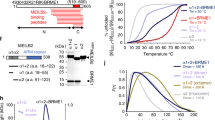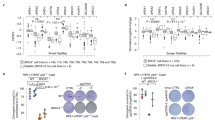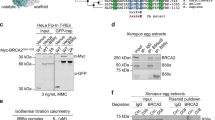Abstract
Brca1 deficiency leads to the development of breast cancer. We previously found that Brca1 deficiency activates the Akt oncogenic pathway. Reduced expression of Brca1 was highly correlated with increased activated Akt in human breast cancer samples. Furthermore, activation of Akt1 was involved in Brca1-deficiency-mediated tumorigenesis in mice. Defective homologous recombination (HR) is thought to be a major contributor to tumorigenesis in Brca1 deficiency. Here, we show that Akt1 promotes chromosome instability in Brca1-deficent cells. DNA breaks in Brca1-deficent cells are aberrantly joined into complex chromosome rearrangements by a process dependent on Akt1. Depletion of Akt1 increases HR in Brca1-mutant cells, which is rescued by expression of wild-type, but not mutant Akt1 with deletion of Brca1-binding domain. Mechanistically, activated Akt1 in Brca1-deficient cells impairs Chk1 nuclear localization and subsequently disrupts interaction of Chk1 and Rad51 leading to HR defects. Our results indicate that Brca1 deficiency might activate Akt1 contributing to tumorigenesis through regulation of the Chk1-Rad51 signaling.
This is a preview of subscription content, access via your institution
Access options
Subscribe to this journal
Receive 50 print issues and online access
$259.00 per year
only $5.18 per issue
Buy this article
- Purchase on Springer Link
- Instant access to full article PDF
Prices may be subject to local taxes which are calculated during checkout




Similar content being viewed by others
References
Miki Y, Swensen J, Shattuck-Eidens D, Futreal PA, Harshman K, Tavtigian S et al. A strong candidate for the breast and ovarian cancer susceptibility gene BRCA1. Science 1994; 266: 66–71.
Yu X, Chini CC, He M, Mer G, Chen J . The BRCT domain is a phospho-protein binding domain. Science 2003; 302: 639–642.
Ludwig T, Fisher P, Ganesan S, Efstratiadis A . Tumorigenesis in mice carrying a truncating Brca1 mutation. Genes Dev 2001; 15: 1188–1193.
Manke IA, Lowery DM, Nguyen A, Yaffe MB . BRCT repeats as phosphopeptide-binding modules involved in protein targeting. Science 2003; 302: 636–639.
Deng CX . BRCA1: cell cycle checkpoint, genetic instability, DNA damage response and cancer evolution. Nucleic Acids Res 2006; 34: 1416–1426.
Bellacosa A, Kumar CC, Di CA, Testa JR . Activation of AKT kinases in cancer: implications for therapeutic targeting. Adv Cancer Res 2005; 94: 29–86.
Xiang T, Jia Y, Sherris D, Li S, Wang H, Lu D et al. Targeting the Akt/mTOR pathway in Brca1-deficient cancers. Oncogene 2011; 30: 2443–2450.
Xiang T, Ohashi A, Huang Y, Pandita TK, Ludwig T, Powell SN et al. Negative regulation of AKT activation by BRCA1. Cancer Res 2008; 68: 10040–10044.
Moynahan ME, Chiu JW, Koller BH, Jasin M . Brca1 controls homology-directed DNA repair. Mol Cell 1999; 4: 511–518.
Scully R, Ganesan S, Vlasakova K, Chen J, Socolovsky M, Livingston DM . Genetic analysis of BRCA1 function in a defined tumor cell line. Mol Cell 1999; 4: 1093–1099.
Plo I, Laulier C, Gauthier L, Lebrun F, Calvo F, Lopez BS . AKT1 inhibits homologous recombination by inducing cytoplasmic retention of BRCA1 and RAD51. Cancer Res 2008; 68: 9404–9412.
Xu X, Qiao W, Linke SP, Cao L, Li WM, Furth PA et al. Genetic interactions between tumor suppressors Brca1 and p53 in apoptosis, cell cycle and tumorigenesis. Nat Genet 2001; 28: 266–271.
Bunting SF, Callen E, Wong N, Chen HT, Polato F, Gunn A et al. 53BP1 inhibits homologous recombination in Brca1-deficient cells by blocking resection of DNA breaks. Cell 2010; 141: 243–254.
Scully R, Chen J, Plug A, Xiao Y, Weaver D, Feunteun J et al. Association of BRCA1 with Rad51 in mitotic and meiotic cells. Cell 1997; 88: 265–275.
Bhattacharyya A, Ear US, Koller BH, Weichselbaum RR, Bishop DK . The breast cancer susceptibility gene BRCA1 is required for subnuclear assembly of Rad51 and survival following treatment with the DNA cross-linking agent cisplatin. J Biol Chem 2000; 275: 23899–23903.
Bouwman P, Aly A, Escandell JM, Pieterse M, Bartkova J, van der GH et al. 53BP1 loss rescues BRCA1 deficiency and is associated with triple-negative and BRCA-mutated breast cancers. Nat Struct Mol Biol 2010; 17: 688–695.
Nakanishi K, Yang YG, Pierce AJ, Taniguchi T, Digweed M, D'Andrea AD et al. Human Fanconi anemia monoubiquitination pathway promotes homologous DNA repair. Proc Natl Acad Sci USA 2005; 102: 1110–1115.
Sorensen CS, Hansen LT, Dziegielewski J, Syljuasen RG, Lundin C, Bartek J et al. The cell-cycle checkpoint kinase Chk1 is required for mammalian homologous recombination repair. Nat Cell Biol 2005; 7: 195–201.
Puc J, Keniry M, Li HS, Pandita TK, Choudhury AD, Memeo L et al. Lack of PTEN sequesters CHK1 and initiates genetic instability. Cancer Cell 2005; 7: 193–204.
Deng CX . Tumor formation in Brca1 conditional mutant mice. Environ Mol Mutagen 2002; 39: 171–177.
Xu X, Wagner KU, Larson D, Weaver Z, Li C, Ried T et al. Conditional mutation of Brca1 in mammary epithelial cells results in blunted ductal morphogenesis and tumour formation. Nat Genet 1999; 22: 37–43.
Yang Q, Zheng YL, POT1 Harris CC . and TRF2 cooperate to maintain telomeric integrity. Mol Cell Biol 2005; 25: 1070–1080.
Zeng S, Xiang T, Pandita TK, Gonzalez-Suarez I, Gonzalo S, Harris CC et al. Telomere recombination requires the MUS81 endonuclease. Nat Cell Biol 2009; 11: 616–623.
Yang Q, Zhang R, Wang XW, Linke SP, Sengupta S, Hickson ID et al. The mismatch DNA repair heterodimer, hMSH2/6, regulates BLM helicase. Oncogene 2004; 23: 3749–3756.
Yang Q, Zhang R, Wang XW, Spillare EA, Linke SP, Subramanian D et al. The processing of Holliday junctions by BLM and WRN helicases is regulated by p53. J Biol Chem 2002; 277: 31980–31987.
Acknowledgements
We thank Chuxia Deng for providing the Brca1WT and Brca1Δ11/Δ11 MEFs. We thank Buck Rogers and Xiaowei Wang for proof reading. This work is supported in part by grants from the Susan G. Komen Foundation (QY), Siteman Cancer Center Award (QY) and NIH CA129440 (QY).
Author information
Authors and Affiliations
Corresponding author
Ethics declarations
Competing interests
The authors declare no conflict of interest.
Additional information
Supplementary Information accompanies the paper on the Oncogene website
Supplementary information
Rights and permissions
About this article
Cite this article
Jia, Y., Song, W., Zhang, F. et al. Akt1 inhibits homologous recombination in Brca1-deficient cells by blocking the Chk1-Rad51 pathway. Oncogene 32, 1943–1949 (2013). https://doi.org/10.1038/onc.2012.211
Received:
Revised:
Accepted:
Published:
Issue Date:
DOI: https://doi.org/10.1038/onc.2012.211
Keywords
This article is cited by
-
Targeting of AKT-Signaling Pathway Potentiates the Anti-cancer Efficacy of Doxorubicin in A673 Ewing Sarcoma Cell Line
BioNanoScience (2021)
-
Impact of Etoposide on BRCA1 Expression in Various Breast Cancer Cell Lines
Drugs in R&D (2017)
-
RAD51 regulates CHK1 stability via autophagy to promote cell growth in esophageal squamous carcinoma cells
Tumor Biology (2016)



